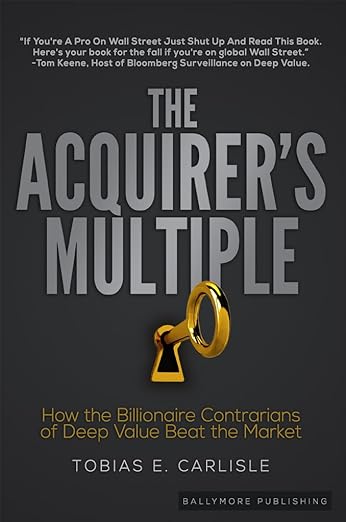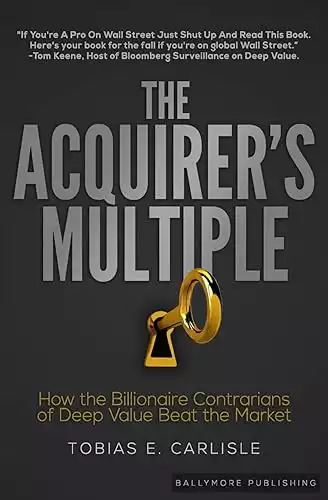Overview : The Acquirer’s Multiple
- Book Title: The Acquirer’s Multiple
- Author: Tobias E. Carlisle
- Publication Date: September 2017
- price: $15.99
- Pages: 242
Overview of the Book
"The Acquirer’s Multiple" is authored by Tobias E. Carlisle, a prominent value investor and financial expert. The book delves into using the acquirer’s multiple, a metric for identifying undervalued companies with high potential for returns.
Introduction
In the ever-evolving world of finance and investing, finding a strategy that consistently beats the market is the holy grail for many investors. Tobias E. Carlisle's book, "The Acquirer's Multiple: How the Billionaire Contrarians of Deep Value Beat the Market," offers a compelling approach to value investing that has piqued the interest of both novice and seasoned investors alike. This review delves into the core concepts of Carlisle's work, exploring its relevance in today's dynamic financial landscape.
Book Summary
Carlisle introduces readers to the Acquirer's Multiple, a valuation metric that has been quietly used by some of the world's most successful investors to identify undervalued companies. The book's central thesis revolves around the idea that by focusing on this simple yet powerful ratio—enterprise value divided by operating earnings—investors can uncover hidden gems in the market that have the potential for substantial returns.
"The Acquirer's Multiple is the best, most comprehensive measure of value. It's the one I'd use if I could only pick one." - Tobias E. Carlisle
Throughout the book, Carlisle weaves together historical data, case studies, and insights from legendary investors to build a compelling case for his deep value investing approach. He argues that by adopting a contrarian mindset and focusing on fundamentals rather than market sentiment, investors can position themselves to outperform the market over the long term.
Analysis of Themes
The Power of Contrarian Thinking
One of the book's strongest themes is the importance of contrarian thinking in investing. Carlisle challenges readers to look beyond popular stocks and market trends, instead focusing on overlooked or unpopular companies that may be trading at a discount to their intrinsic value. This approach requires mental fortitude and the ability to resist the herd mentality that often dominates market behavior.
The Psychological Aspect of Investing
Carlisle dedicates significant attention to the psychological challenges of value investing. He emphasizes that successful investing is not just about identifying undervalued stocks but also about having the discipline to stick to one's strategy during periods of market volatility or underperformance. This focus on investor psychology adds depth to the book, making it more than just a guide to stock picking.
The Role of Quantitative Analysis
While the Acquirer's Multiple is at the heart of Carlisle's strategy, the book also touches on the broader role of quantitative analysis in investing. Carlisle demonstrates how simple metrics can often outperform more complex valuation models, challenging the notion that sophisticated financial engineering is necessary for investment success.
Writing Style
Carlisle's writing style is clear and accessible, making complex financial concepts digestible for readers with varying levels of investment knowledge. He strikes a balance between technical analysis and storytelling, using real-world examples to illustrate his points and keep readers engaged throughout the book.
Strengths and Weaknesses
Strengths:
- Clear explanation of a powerful investment strategy
- Backed by extensive historical data and research
- Practical advice for implementing the strategy
- Insightful discussion on investor psychology
Weaknesses:
- May oversimplify the complexities of investing for some readers
- The strategy's effectiveness in different market conditions could be explored more
- Limited discussion on how the approach applies to emerging trends like cryptocurrencies
Comparison to Other Works
"The Acquirer's Multiple" builds on the value investing principles established by Benjamin Graham and Warren Buffett, but it offers a more focused and quantitative approach. Compared to classics like "The Intelligent Investor" or "Security Analysis," Carlisle's work is more accessible to modern readers and provides a more actionable strategy. When placed alongside contemporary works like Joel Greenblatt's "The Little Book That Beats the Market," Carlisle's book offers a similar quantitative approach but with a deeper dive into the psychological aspects of contrarian investing.
Highlights from The Acquirer’s Multiple
- Acquirer's Multiple: Focuses on using a value investing strategy based on low enterprise value to earnings before interest and taxes (EV/EBIT).
- Undervalued stocks: Emphasizes identifying undervalued companies with strong fundamentals for potential acquisition.
- Margin of safety: Advocates for investing with a margin of safety to reduce risk.
- Long-term approach: Encourages a patient, long-term investment horizon.
- Acquisition strategy: Uses the acquirer's multiple to find companies ripe for potential takeover.
- Risk management: Focuses on minimizing risks through rigorous financial analysis.
Conclusion
"The Acquirer's Multiple" is a valuable addition to any investor's library, particularly for those interested in value investing and contrarian strategies. Carlisle's approach offers a fresh perspective on identifying undervalued stocks in today's market, making it relevant for both personal finance enthusiasts and professional investors. While the book's focus on a single metric may not appeal to all investors, its insights into market behavior and investor psychology make it a worthwhile read even for those who may not fully adopt the Acquirer's Multiple strategy. For readers looking to expand their investment knowledge and potentially improve their returns, "The Acquirer's Multiple" provides a solid foundation in value investing principles with a modern twist.





